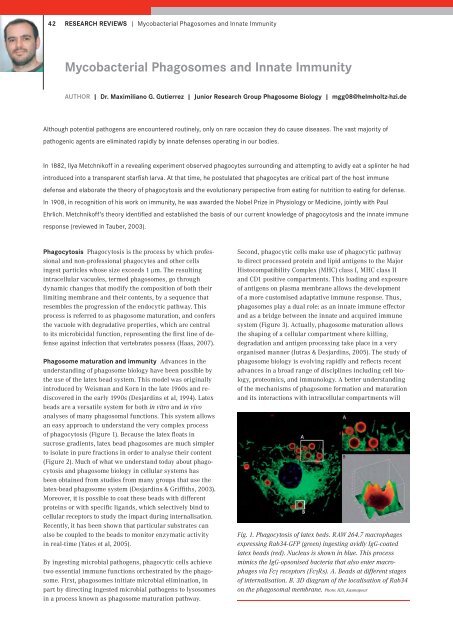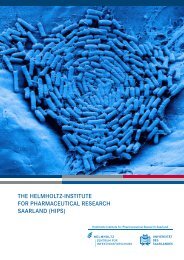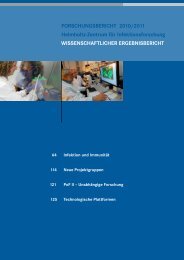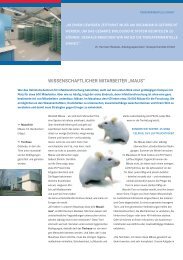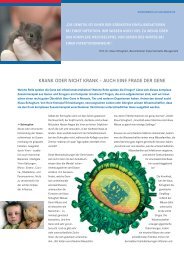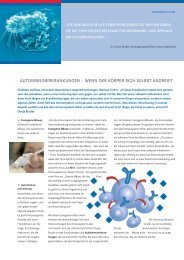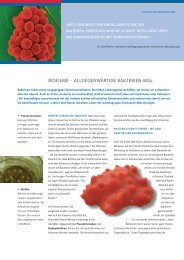Research Report 2010 2011 - Helmholtz-Zentrum für ...
Research Report 2010 2011 - Helmholtz-Zentrum für ...
Research Report 2010 2011 - Helmholtz-Zentrum für ...
You also want an ePaper? Increase the reach of your titles
YUMPU automatically turns print PDFs into web optimized ePapers that Google loves.
42 RESEARCH REVIEWS | Mycobacterial Phagosomes and Innate Immunity<br />
Mycobacterial Phagosomes and Innate Immunity<br />
AUTHOR | Dr. Maximiliano G. Gutierrez | Junior <strong>Research</strong> Group Phagosome Biology | mgg08@helmholtz-hzi.de<br />
Although potential pathogens are encountered routinely, only on rare occasion they do cause diseases. The vast majority of<br />
pathogenic agents are eliminated rapidly by innate defenses operating in our bodies.<br />
In 1882, Ilya Metchnikoff in a revealing experiment observed phagocytes surrounding and attempting to avidly eat a splinter he had<br />
introduced into a transparent starfi sh larva. At that time, he postulated that phagocytes are critical part of the host immune<br />
defense and elaborate the theory of phagocytosis and the evolutionary perspective from eating for nutrition to eating for defense.<br />
In 1908, in recognition of his work on immunity, he was awarded the Nobel Prize in Physiology or Medicine, jointly with Paul<br />
Ehrlich. Metchnikoff’s theory identifi ed and established the basis of our current knowledge of phagocytosis and the innate immune<br />
response (reviewed in Tauber, 2003).<br />
Phagocytosis Phagocytosis is the process by which professional<br />
and non-professional phagocytes and other cells<br />
ingest particles whose size exceeds 1 μm. The resulting<br />
intracellular vacuoles, termed phagosomes, go through<br />
dynamic changes that modify the composition of both their<br />
limiting membrane and their contents, by a sequence that<br />
resembles the progression of the endocytic pathway. This<br />
process is referred to as phagosome maturation, and confers<br />
the vacuole with degradative properties, which are central<br />
to its microbicidal function, representing the first line of defense<br />
against infection that vertebrates possess (Haas, 2007).<br />
Phagosome maturation and immunity Advances in the<br />
understanding of phagosome biology have been possible by<br />
the use of the latex bead system. This model was originally<br />
introduced by Weisman and Korn in the late 1960s and rediscovered<br />
in the early 1990s (Desjardins et al, 1994). Latex<br />
beads are a versatile system for both in vitro and in vivo<br />
analyses of many phagosomal functions. This system allows<br />
an easy approach to understand the very complex process<br />
of phagocytosis (Figure 1). Because the latex floats in<br />
sucrose gradients, latex bead phagosomes are much simpler<br />
to isolate in pure fractions in order to analyse their content<br />
(Figure 2). Much of what we understand today about phagocytosis<br />
and phagosome biology in cellular systems has<br />
been obtained from studies from many groups that use the<br />
latex-bead phagosome system (Desjardins & Griffiths, 2003).<br />
Moreover, it is possible to coat these beads with different<br />
proteins or with specific ligands, which selectively bind to<br />
cellular receptors to study the impact during internalisation.<br />
Recently, it has been shown that particular substrates can<br />
also be coupled to the beads to monitor enzymatic activity<br />
in real-time (Yates et al, 2005).<br />
By ingesting microbial pathogens, phagocytic cells achieve<br />
two essential immune functions orchestrated by the phagosome.<br />
First, phagosomes initiate microbial elimination, in<br />
part by directing ingested microbial pathogens to lysosomes<br />
in a process known as phagosome maturation pathway.<br />
Second, phagocytic cells make use of phagocytic pathway<br />
to direct processed protein and lipid antigens to the Major<br />
Histocompatibility Complex (MHC) class I, MHC class II<br />
and CD1 positive compartments. This loading and exposure<br />
of antigens on plasma membrane allows the development<br />
of a more customised adaptative immune response. Thus,<br />
phagosomes play a dual role: as an innate immune effector<br />
and as a bridge between the innate and acquired immune<br />
system (Figure 3). Actually, phagosome maturation allows<br />
the shaping of a cellular compartment where killing,<br />
degradation and antigen processing take place in a very<br />
organised manner (Jutras & Desjardins, 2005). The study of<br />
phagosome biology is evolving rapidly and reflects recent<br />
advances in a broad range of disciplines including cell biology,<br />
proteomics, and immunology. A better understanding<br />
of the mechanisms of phagosome formation and maturation<br />
and its interactions with intracellular compartments will<br />
Fig. 1. Phagocytosis of latex beds. RAW 264.7 macrophages<br />
expressing Rab34-GFP (green) ingesting avidly IgG-coated<br />
latex beads (red). Nucleus is shown in blue. This process<br />
mimics the IgG-opsonised bacteria that also enter macrophages<br />
via Fcγ receptors (FcγRs). A. Beads at different stages<br />
of internalisation. B. 3D diagram of the localisation of Rab34<br />
on the phagosomal membrane. Photo: HZI, Kasmapour


